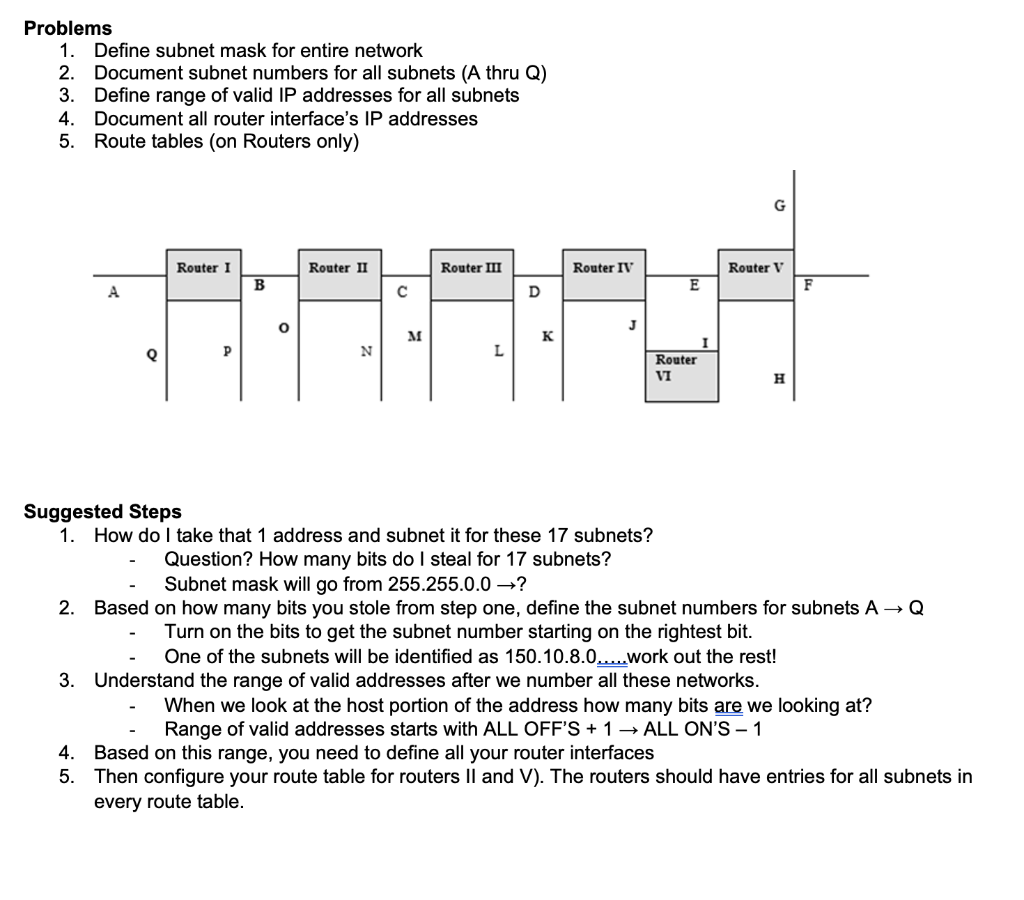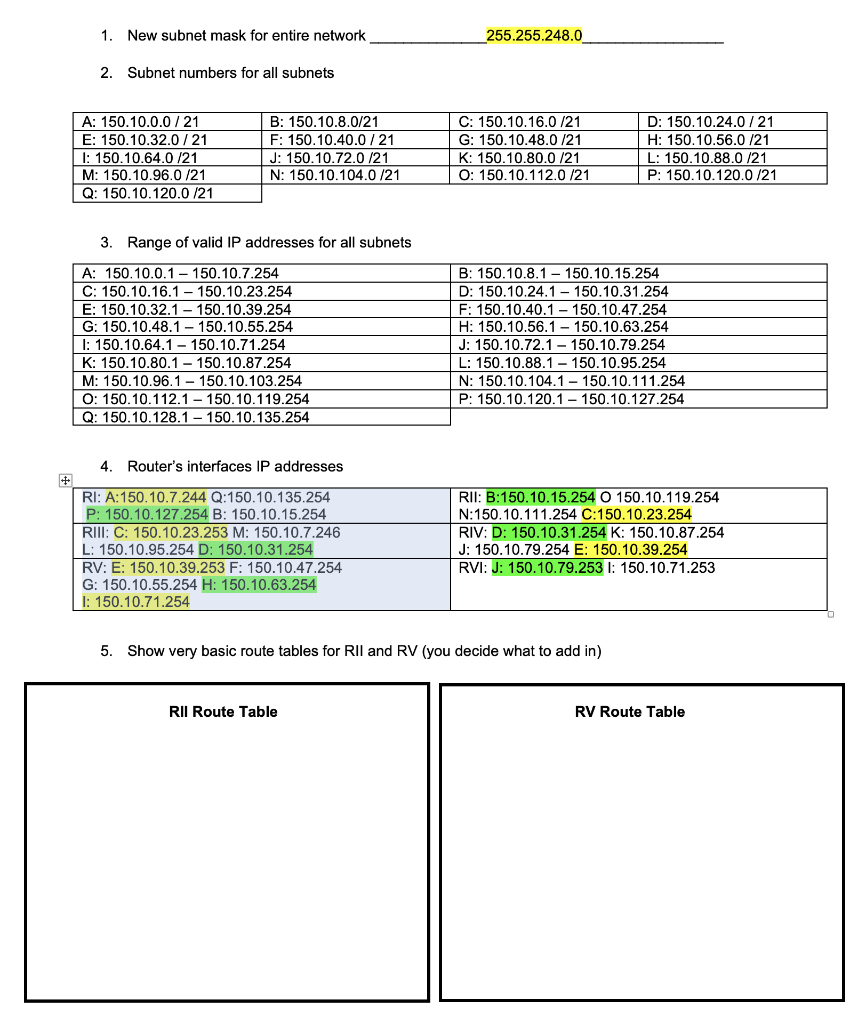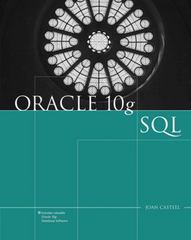I need help with the very last question (question 5) which is showing a very basic routing table for R2 and R5. All the other work is done. Thanks.


Problems 1. Define subnet mask for entire network 2. Document subnet numbers for all subnets (A thru Q) 3. Define range of valid IP addresses for all subnets 4. Document all router interface's IP addresses 5. Route tables (on Routers only) Router I Router II Router III Router IV Router V B F E A D o J M Q P N L I Router VI H Suggested Steps 1. How do I take that 1 address and subnet it for these 17 subnets? Question? How many bits do I steal for 17 subnets? Subnet mask will go from 255.255.0.0 ? 2. Based on how many bits you stole from step one, define the subnet numbers for subnets A Q Turn on the bits to get the subnet number starting on the rightest bit. One of the subnets will be identified as 150.10.8.0...... work out the rest! 3. Understand the range of valid addresses after we number all these networks. When we look at the host portion of the address how many bits are we looking at? Range of valid addresses starts with ALL OFF'S + 1 + ALL ON'S - 1 4. Based on this range, you need to define all your router interfaces 5. Then configure your route table for routers II and V). The routers should have entries for all subnets in every route table. 1. New subnet mask for entire network 255.255.248.0 2. Subnet numbers for all subnets A: 150.10.0.0 / 21 E: 150.10.32.0 / 21 1: 150.10.64.0 121 M: 150.10.96.0 /21 Q: 150.10.120.0 /21 B: 150.10.8.0/21 F: 150.10.40.0 / 21 J: 150.10.72.0 121 N: 150.10.104.0 /21 C: 150.10.16.0 /21 G: 150.10.48.0 121 K: 150.10.80.0 121 O: 150.10.112.0 121 D: 150.10.24.0 / 21 H: 150.10.56.0 /21 L: 150.10.88.0 121 P: 150.10.120.0 /21 3. Range of valid IP addresses for all subnets A: 150.10.0.1 150.10.7.254 C: 150.10.16.1 150.10.23.254 E: 150.10.32.1 - 150.10.39.254 G: 150.10.48.1 - 150.10.55.254 1: 150.10.64.1 - 150.10.71.254 K: 150.10.80.1 - 150.10.87.254 M: 150.10.96.1 150.10.103.254 O: 150.10.112.1 - 150.10.119.254 Q: 150.10.128.1 150.10.135.254 B: 150.10.8.1 - 150.10.15.254 D: 150.10.24.1 - 150.10.31.254 F: 150.10.40.1 - 150.10.47.254 H: 150.10.56.1 - 150.10.63.254 J: 150.10.72.1 - 150.10.79.254 L: 150.10.88.1 - 150.10.95.254 N: 150.10.104.1 - 150.10.111.254 P: 150.10.120.1 - 150.10.127.254 4. Router's interfaces IP addresses RI: A:150.10.7.244 Q:150.10.135.254 P: 150.10.127.254 B: 150.10.15.254 RIII: C: 150.10.23.253 M: 150.10.7.246 L: 150.10.95.254 D: 150.10.31.254 RV: E: 150.10.39.253 F: 150.10.47.254 G: 150.10.55.254 H: 150.10.63.254 I: 150.10.71.254 RII: B:150.10.15.254 O 150.10.119.254 N: 150.10.111.254 C:150.10.23.254 RIV: D: 150.10.31.254 K: 150.10.87.254 J: 150.10.79.254 E: 150.10.39.254 RVI: J: 150.10.79.253 I: 150.10.71.253 5. Show very basic route tables for Rll and RV (you decide what to add in) RII Route Table RV Route Table Problems 1. Define subnet mask for entire network 2. Document subnet numbers for all subnets (A thru Q) 3. Define range of valid IP addresses for all subnets 4. Document all router interface's IP addresses 5. Route tables (on Routers only) Router I Router II Router III Router IV Router V B F E A D o J M Q P N L I Router VI H Suggested Steps 1. How do I take that 1 address and subnet it for these 17 subnets? Question? How many bits do I steal for 17 subnets? Subnet mask will go from 255.255.0.0 ? 2. Based on how many bits you stole from step one, define the subnet numbers for subnets A Q Turn on the bits to get the subnet number starting on the rightest bit. One of the subnets will be identified as 150.10.8.0...... work out the rest! 3. Understand the range of valid addresses after we number all these networks. When we look at the host portion of the address how many bits are we looking at? Range of valid addresses starts with ALL OFF'S + 1 + ALL ON'S - 1 4. Based on this range, you need to define all your router interfaces 5. Then configure your route table for routers II and V). The routers should have entries for all subnets in every route table. 1. New subnet mask for entire network 255.255.248.0 2. Subnet numbers for all subnets A: 150.10.0.0 / 21 E: 150.10.32.0 / 21 1: 150.10.64.0 121 M: 150.10.96.0 /21 Q: 150.10.120.0 /21 B: 150.10.8.0/21 F: 150.10.40.0 / 21 J: 150.10.72.0 121 N: 150.10.104.0 /21 C: 150.10.16.0 /21 G: 150.10.48.0 121 K: 150.10.80.0 121 O: 150.10.112.0 121 D: 150.10.24.0 / 21 H: 150.10.56.0 /21 L: 150.10.88.0 121 P: 150.10.120.0 /21 3. Range of valid IP addresses for all subnets A: 150.10.0.1 150.10.7.254 C: 150.10.16.1 150.10.23.254 E: 150.10.32.1 - 150.10.39.254 G: 150.10.48.1 - 150.10.55.254 1: 150.10.64.1 - 150.10.71.254 K: 150.10.80.1 - 150.10.87.254 M: 150.10.96.1 150.10.103.254 O: 150.10.112.1 - 150.10.119.254 Q: 150.10.128.1 150.10.135.254 B: 150.10.8.1 - 150.10.15.254 D: 150.10.24.1 - 150.10.31.254 F: 150.10.40.1 - 150.10.47.254 H: 150.10.56.1 - 150.10.63.254 J: 150.10.72.1 - 150.10.79.254 L: 150.10.88.1 - 150.10.95.254 N: 150.10.104.1 - 150.10.111.254 P: 150.10.120.1 - 150.10.127.254 4. Router's interfaces IP addresses RI: A:150.10.7.244 Q:150.10.135.254 P: 150.10.127.254 B: 150.10.15.254 RIII: C: 150.10.23.253 M: 150.10.7.246 L: 150.10.95.254 D: 150.10.31.254 RV: E: 150.10.39.253 F: 150.10.47.254 G: 150.10.55.254 H: 150.10.63.254 I: 150.10.71.254 RII: B:150.10.15.254 O 150.10.119.254 N: 150.10.111.254 C:150.10.23.254 RIV: D: 150.10.31.254 K: 150.10.87.254 J: 150.10.79.254 E: 150.10.39.254 RVI: J: 150.10.79.253 I: 150.10.71.253 5. Show very basic route tables for Rll and RV (you decide what to add in) RII Route Table RV Route Table








